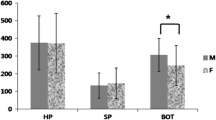Abstract
Background
The aim of this study was to present a novel anatomically comprehensive and clinically applicable system for the quantification of sleep endoscopy findings in patients with obstructive sleep apnea/hypopnea syndrome (OSAHS).
Methods
Fifty-five adult patients with a polysomnographic diagnosis of OSAHS were referred for midazolam-induced sleep endoscopy following failure of continuous positive airway pressure. Five anatomical sites of possible obstruction along the upper airway were documented: nose/nasopharynx (N), uvulopalatine plane (P), tongue base (T), larynx (L), and hypopharynx (H). Each involved site was assigned a severity grade of 1 (partial obstruction) or 2 (complete obstruction). The digits representing the obstruction pattern at each level were then added to yield a severity index (SI). The SI for each patient was determined by two independent observers. Findings were correlated with the respiratory disturbance index (RDI) and body mass index (BMI).
Results
The SI was significantly correlated with the RDI (R = 0.746, Pearson; P < 0.0001) and predicted disease severity with 65% accuracy. There was no association with BMI. By site, the tongue base and hypopharynx were significantly correlated with obstruction severity; obstruction in the tongue base predicted disease severity with a sensitivity of 68.8 and sensitivity of 81.1.
Conclusion
Our easy-to-use endoscopic grading system provides physicians with an accurate picture of the pattern of the upper-airway system obstruction in patients with obstructive sleep apnea/hypopnea syndrome. It is a promising tool for estimating the location and severity of upper airway disease and may have implications for treatment planning.

Similar content being viewed by others
References
Young T, Palta M, Dempsey J et al (1993) The occurrence of sleep-disordered breathing among middle-aged adults. N Engl J Med 328(17):1230–1235
Phillipson EA (1993) Sleep apnea–a major public health problem. N Engl J Med 328(17):1271–1273 Comment 328(17):1230–1235
Poceta JS, Loube DI, Kellgren EL et al (1999) Mortality in obstructive sleep apnea: Association with impaired wakefulness. Sleep Breath 3(1):3–8
Croft CB, Pringle M (1991) Sleep nasendoscopy: a technique of assessment in snoring and obstructive sleep apnoea. Clin Otolaryngol Allied Sci 16(5):504–509
Quinn SJ, Daly N, Ellis PD (1995) Observation of the mechanism of snoring using sleep nasendoscopy. Clin Otolaryngol Allied Sci 20(4):360–364
Pringle MB, Croft CB (1991) A comparison of sleep nasendoscopy and the Muller manoeuvre. Clin Otolaryngol Allied Sci 16(6):559–562
Pringle MB, Croft CB (1993) A grading system for patients with obstructive sleep apnoea based on sleep nasendoscopy. Clin Otolaryngol Allied Sci 18(6):480–484
Abdullah VJ, Wing YK, van Hasselt CA (2003) Video sleep nasendoscopy: the Hong Kong experience. Otolaryngol Clin North Am 36(3):461–471 vi
Sadaoka T, Kakitsuba N, Fujiwara Y et al (1996) The value of sleep nasendoscopy in the evaluation of patients with suspected sleep-related breathing disorders. Clin Otolaryngol Allied Sci 21(6):485–489
Bachar G, Feinmesser R, Shpitzer T et al (2008) Laryngeal and hypopharyngeal obstruction in sleep disordered breathing patients evaluated by sleep endoscopy. Eur Arch Otorhinolaryngol 265(11):1397–1402
Kushida CA, Littner MR, Morgenthaler T et al (2005) Practice parameters for the indications for polysomnography and related procedures: an update for 2005. Sleep 28(4):499–521
Camilleri AE, Ramamurthy L, Jones PH (1995) Sleep nasendoscopy: what benefit to the management of snorers? J Laryngol Otol 109(12):1163–1165
Iwanaga K, Hasegawa K, Shibata N et al (2003) Endoscopic examination of obstructive sleep apnea syndrome patients during drug-induced sleep. Acta Otolaryngol Suppl 550:36–40
Sher AE, Shprintzen RJ, Thorpy MJ (1986) Endoscopic observations of obstructive sleep apnea in children with anomalous upper airways: predictive and therapeutic value. Int J Pediatr Otorhinolaryngol 11(2):135–146
Higami S, Inoue Y, Higami Y et al (2002) Endoscopic classification of pharyngeal stenosis pattern in obstructive sleep apnea hypopnea syndrome. Psychiatry Clin Neurosci 56(3):317–318
Conflicts of Interest
The authors have no conflicts of interest to disclose.
Author information
Authors and Affiliations
Corresponding author
Additional information
G. Bachar and B. Nageris contributed equally to this work.
Rights and permissions
About this article
Cite this article
Bachar, G., Nageris, B., Feinmesser, R. et al. Novel Grading System for Quantifying Upper-Airway Obstruction on Sleep Endoscopy. Lung 190, 313–318 (2012). https://doi.org/10.1007/s00408-011-9367-3
Received:
Accepted:
Published:
Issue Date:
DOI: https://doi.org/10.1007/s00408-011-9367-3



